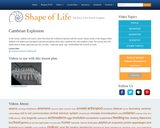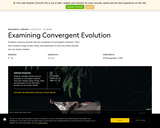
This parent guide supports parents in helping their child at home with the 8th grade Science content.
- Subject:
- Science
- Material Type:
- Reference Material
- Vocabulary
- Author:
- Kelly Rawlston
- Letoria Lewis
- Date Added:
- 10/11/2022

This parent guide supports parents in helping their child at home with the 8th grade Science content.

This resource accompanies our Rethink 8th Grade Science course. It includes ideas for use, ways to support exceptional children, ways to extend learning, digital resources and tools, tips for supporting English Language Learners and students with visual and hearing impairments. There are also ideas for offline learning.

Students watch a video of a gliding lizard to examine characteristics that enable flight. They record in chart form characteristics and abilities of four pterosaurs to see how these animals adapted to survive over millions of years.

Students will watch a short film about the Cambrian Explosion and the extraordinary fossils of the Burgess Shale. Students will address preconceptions and misconceptions about early Cambrian life, and complete a timeline activity that will enable them to better appreciate just how recently - relatively speaking - multicellular life evolved on Earth.

This brief video lesson discusses the surprising “back from the dead†discovery of the coelacanth and explains how this fish’s fins shed light on the evolutionary movement of vertebrates from water to land. Discussion/assessment questions and suggested supplemental resources are also included.

In this activity, students will "dig" for paper fossils and make observations of various fossils to determine characteristics of chimpanzees and humans. Students will then use their new knowledge to dig up and analyze a new fossil discovery that must be presented, with evidence, to the scientific community (class) during and oral presentation.

Dolphins and other marine mammals have pretty big brains compared to the size of their bodies. That?s one indication of high intelligence, and anyone who has seen them perform at an aquarium or zoo can attest to that fact. This Science Update introduces us to one scientist who?s trying to find out how dolphins got so brainy.

Students examine animals that are examples of convergent evolution. They then analyze wings of bats, birds, and pterosaurs to see why these animals are not closely related.

This worksheet supports the HHMI short film The Day the Mesozoic Died. As students watch the film, they will write down the evidence that led to the discovery that an asteroid struck Earth about 66 million years ago, causing a mass extinction. Through this exercise students gain an appreciation for the scientific process, which consists of asking questions, making observations, formulating hypotheses, and gathering and evaluating evidence.

Introduce and explore various types of landforms.
GeoInquiries are designed to be fast and easy-to-use instructional resources that incorporate advanced web mapping technology. Each 15-minute activity in a collection is intended to be presented by the instructor from a single computer/projector classroom arrangement. No installation, fees, or logins are necessary to use these materials and software.

In this multimedia lesson, students learn about deep-sea ecosystems. Associated interactive activities include "Hydrothermal Vent Food Webs," where students reconstruct a hydrothermal vent fauna food web on a digital diagram and "Evolutionary Puzzle," where students investigate how evolutionary relationships support the theory of plate tectonics.

This course was created by the Rethink Education Content Development Team. This course is aligned to the NC Standards for 8th Grade Science.

This course was created by the Rethink Education Content Development Team. This course is aligned to the NC Standards for 8th Grade Science.

This course was created by the Rethink Education Content Development Team. This course is aligned to the NC Standards for 8th Grade Science.

Students use observation skills to determine taxonomic differences between seals and sea lions.

Students assess evolutionary links and evidence from comparative analysis of the fossil record and modern day organisms. Using the information about the Cambrian Explosion, they explore theories about how and why organisms divesrsified then hypothesize what evidence might be helpful to connect fossil organisms to show evolutionary connections.

Students view a slideshow presentation with imbedded videos and images of the skeletal evolution of humans and chimpanzees. The fossil skeleton of Ardipithecus ramidus is compared with the skeletons of humans and chimpanzees to better understand the branching that took place during evolution.

Students practice scientific thinking to understand evidence and inference, within the context of fossils' use as a record of the past.

This encyclopedia entry is for the term "Fossils." Fossils are the preserved remains, or traces of remains, of ancient animals and plants. Text for this entry is appropriate for the middle and high school grade levels.